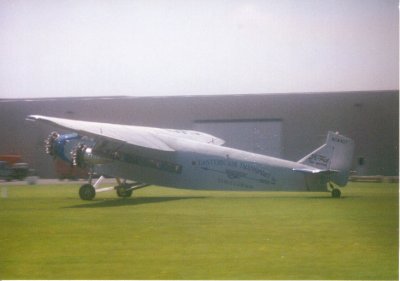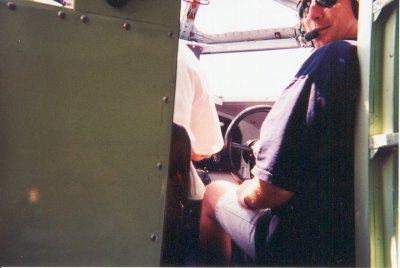1929 Ford
Tri-Motor
EAA's Ford Tri-Motor has a storied past. The
146th of 199 tri-motored Fords, it's first flight was on August 21, 1929.
Registration number NC8407 was assigned. It's first owner was Eastern
Air Transport, which later would become Eastern Airlines. It flew
for E.A.T. for nearly a year, and on October 1, 1930 it was sold to Intercontinent
Aviation for lease to Cubana Curtiss (purchased by Pan Am in 1932).
The plane was used to inaugurate Cubana's very first passenger (and mail)
route from Havana to Santiago de Cuba. It also doubled as a multi-engine
trainer at the Curtiss flight school in Havana. 1933 saw the only
accident it would suffer during it's service with Cubana. During
a landing rollout at Santiago de Cuba the left main tire dropped off the
runway surface and dug into the soft dirt. The plane came to rest on the
center engine with the tail in the air. The plane was repaired and
continued to fly in Cuba until 1946 when it was leased and later sold to
Dominicana de Aviacion. It was transferred to the Dominican Air Force
in 1948, becoming the airplane used to transport the Dominican president.
| The all-metal bird taxies before another flight. |
 |
In July of 1949, NC8407 returned to the U.S. and started
a new life. In 1955 the Ford became a borate bomber as two 250 gallon
tanks with a pair of 19 x 20" "bomb bay" doors were added. It did
service in the Payette and Boise National Forests. In 1958 it was
sold again and used for smoke jumping operations. at various times
it was also used as a crop duster, with full span spray bars attached from
the engine cowlings to the wing tips.
In 1965 the big Ford made an appearance in the Jerry
Lewis movie The Family Jewels. In the film, Lewis played an
inept airline entrepreneur, with NC8407 his only airplane. In the
late 60's, the plane was often brought to air shows to sell rides.
A visit to Burlington, WI. for an EAA air show fundraiser for the EAA museum
in the early 70's brought disaster. The Ford and 11 other airplanes
were damaged or destroyed by a tornado. The insurance company declared
the Ford a total loss, and shortly thereafter offered to sell it to the
EAA. The wreck sat for a few years before Paul Poberezny and others
decided that EAA volunteers were up to the challenge of restoring it.
The restoration was completed in 1986, and ever since the "tin Goose" has
been actively flown to promote the positive image of EAA. It is a
popular attraction at Pioneer Airport, and also makes appearances across
the midwest, offering people the chance to experience an airplane that
played an important role in aviation history.
 |
Here's a picture of me in the co-pilot's seat. I really prefer sitting
up front and being able to see directly ahead of me! And it was worth the
extra money to get to sit here. I even got to fly a little. What a difference
from a Cessna 172! This picture was taken by my dad, who was sitting in
the first seat on the left. |
| This was my dad's view out his window. Here you can see the AirVenture
convention grounds being prepared for the 1997 fly-in. |
 |
Home



